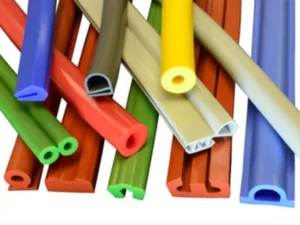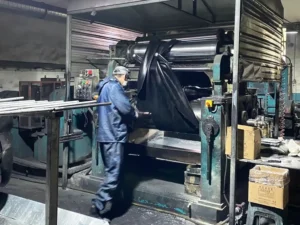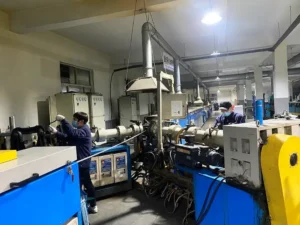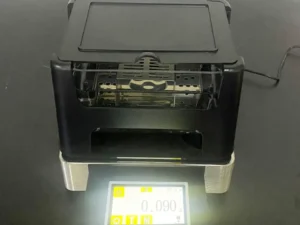EPDM stands for Ethylene Propylene Diene Monomer. It is a versatile material for making many rubber products, including EPDM rubber extrusion profiles. You can see a wide range of EPDM rubber extrusion shapes. For example, sheet, O-ring, cord, solid square, tubes, e, P, T, and other extrusion profiles are noteworthy.

EPDM is beneficial in many ways. It is excellently resistant to weather, UV, and ozone and is used in EPDM rubber extrusion profiles. It also has other benefits.
EPDM rubber extrusion is generally a process of making EPDM rubber profiles. In this article, we will mainly discuss this process. We will learn its benefits and some frequently asked questions.
What is EPDM Rubber Extrusion?
EPDM rubber extrusion is a method of shaping EPDM rubber into specific profiles. There are different steps, from getting the items ready to finishing and testing. These shapes can be weatherstripping, seals, gaskets, or tubes. Extruded EPDM shapes are used in every industry. Even in the food industry, these rubber strips seal large metal containers. In this case, though, nitrile extrusion profiles are typical.
EPDM rubber profiles can be chosen if your application needs a reliable, long-lasting seal. For example, your car door and window need them, as do your house door, windows, cabinet, or other openings. You can think of different uses, too. We will talk about them later. Before that, let’s learn how EPDM rubber extrusion works in real-life manufacturing.
Step #1 Preparing the Material
Formulating is a crucial step before mixing all the raw materials. As you know, EPDM has three base materials: ethylene, Propylene, and Diene Monomer. The formulation of these materials usually determines the final properties of the rubber. So, the formulation is crucial for hardness, color, and resistivity.

Once the formulation is done, you can mix the raw materials in a large mixer or mill. This is not the hopper. It may be a different machine or the same one. The primary purpose of this equipment is to create different EPDM compounds.
Step #2 EPDM Rubber Extrusion Process
Firstly, feed the EPDM rubber into the hopper of an extruder. Note that an extruder is a type of machine with a barrel, screw, and die.
Once the raw materials are fed, the barrel of the extruder heats them. The molten rubber compound then moves forward with the help of a screw. As you know, molten EPDM rubber is easy to shape. You must control the temperature to avoid degrading the material.

When the screw rotates, the molten EPDM rubber moves forward. The force created by this screw usually allows molten material to pass through the die. The die, here, is a specialized tool that mainly shapes the rubber compound. The wide range of EPDM profile shapes you see in the market is due to this die. So, die-making is a very crucial part of manufacturing. It may be costly based on the shapes of the final profile.
The vulcanization process is used in some quality manufacturing, like the seashore rubber factory. After extrusion from the barrel, the extruded rubber compound is further pre-heated. Then, the curing process is operated.
Note that curing is also a type of continuous heating process. It creates cross-links between polymer chains to improve elasticity, strength, and durability.
Step #3 Extruded EPDM Cooling
When the molten rubber compound comes out of the die, it is soft and hot. A cooling process is crucial to giving it a good shape. Depending on your convenience and manufacturing facilities, you can cool it by air or water. Note that proper cooling is essential for shape and dimensional stability.
Step #4 Extruded EPDM Cutting & Finishing
After cooling, you can cut the extruded EPDM rubber profiles into your desired length. Depending on your production needs, you can also make coils.
These extruded EPDMs may need finishing. For example, the profile may have excess material that needs to be trimmed. Moreover, surface treatment methods may also be required.
Step #5 Extruded EPDM Quality Inspection
After cutting and finishing, we test the extruded rubber for quality at the Seashore rubber plant. From this step, different certifications are given out. Customers can believe these certifications to say that the product and the factory are good.

What are the key Features of EPDM Extrusion?
EPDM Extrusion has several exciting features, making it suitable for many uses. Each feature is ideal for unique applications. Therefore, when choosing an EPDM extrusion profile, focus on the exact specs. This can technically help you find the correct product for your job. Let’s check out those features one by one.
Feature #1 Weather & UV Resistance
EPDM rubber is highly resistant to weathering, ozone, and UV. Because of this, EPDM extrusion profiles are ideal for most outdoor sealing jobs. These rubber seal strips are also suitable for use when exposed to UV radiation. You can find its use in your car, house, or electronic devices.
Feature #2 Thermal Stability
EPDM extrusion profiles can withstand a wide range of temperatures. The typical range is between -40 degrees Celsius to 250 degrees Celsius. So, you can realize that EPDM seal strips can work smoothly even in extreme temperatures. You may find this example in engine components and HVAC systems.
Feature #3 Excellent Durability
EPDM profile extrusion usually makes rubber products more durable. The curing or vulcanization method makes these profiles even more durable. They can endure stress and degradation. Therefore, you don’t have to worry about upkeep and costs.
Feature #4 Impact Absorption Properties
EPDM rubber extrusion profiles have excellent impact resistance ability. You can use them for cushioning and vibration-dampening jobs. However, you can use them in your car components, machine mounts, or construction seals.
Feature #5 Lightweight & Easy to Install
EPDM extrusions are relatively lighter than other rubber profiles. They are easy to set up because they are not heavy. You already know that this feature is essential for construction jobs. Also, the materials for cars need to be lighter. This feature makes quick changes and fits easily, even in small spaces.
Feature #6 Suitable for Various Environments
EPDM rubber extrusion profiles can work in diverse environments. You can use it in both indoor and outdoor environments. For outdoor, it works smoothly in both hot summer and cold winter. So, EPDM extrusion profiles are highly versatile.
Feature #7 Different Shore Hardness Availability
Finally, you have many options for the shore hardness of EPDM rubber extrusion profiles. However, the typical shore hardness is 61 degrees to 69. Therefore, you can offer customization to your customers. Shore hardness is the rubber’s stiffness and flexibility. This property of rubber is significant for the optimal performance of a system.
Frequently Asked Question
What is the difference between extruded and molded rubber?
Molded and extruded rubber mainly vary in their making process. Extruded rubber comes from extrusion, which forces raw rubber through a die to get specific shapes. The size mostly depends on the size of the dies. Because of this, you can get a consistent cross-section. On the other hand, molded rubber comes from the molding process. In this process, you will need a mold cavity, and then you will pour the molten rubber into this cavity. When cooled, you will get precisely the same shape as the mold cavity. You can create tons of rubber products in this process. However, the best type depends mainly on your application and rubber product.
What is EPDM rubber good for?
EPDM rubber is mainly suitable for outdoor applications. People often use it to weatherstrip on house or car doors, windows, and cabinets. EPDM has excellent resistance to weather, ozone, and UV. Thus, it is prevalent in roofing, seals, and hoses. You can also use it for electrical insulation.
Is EPDM 100% waterproof?
Yes, but only when you have installed it correctly. EPDM is highly resistant to water and weather, making it ideal for outdoor situations. You can use it for roofing, pond liners, and various water-sealing jobs.
What is RMA tolerance?
RMA stands for Rubber Manufacturers Association. RMA tolerance is the number of flaws that are acceptable during production. These certificates are essential if you make or buy rubber goods.
Summary
EPDM rubber extrusion is a rubber manufacturing process. It makes long and continuous shapes from EPDM rubber compounds. You can make it as long as you can. The making process usually forces the raw rubber to the die and makes various shapes. The shape of the profile mostly depends on the die used in the process.
EPDM extrusion profiles are ideal for outdoor use. As you know, EPDM is highly resistant to weather, ozone, and UV. Other benefits of using the EPDM rubber profile are flexibility, durability, and thermal stability. When discussing thermal activity, you should know that EPDM can withstand up to -50 degrees to 250 degrees Celsius. In Fahrenheit, this must be -60 degrees to 300 degrees Fahrenheit.
Contact us today! We offer our customers a wide range of EPDM seal strips and customization services. You can get any design, quality, and color you want. If you have any questions about EPDM rubber extrusion and its products, please get in touch with us. Our team of experts are always happy to assist.
